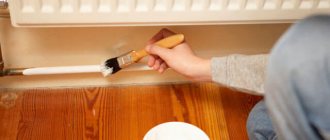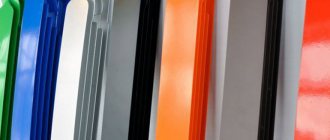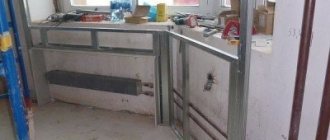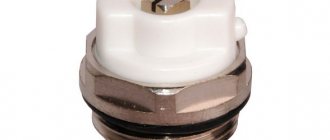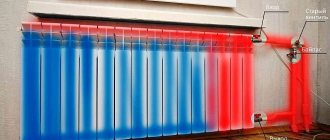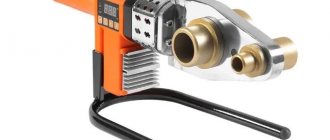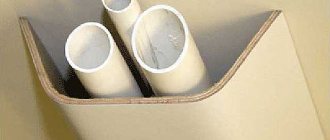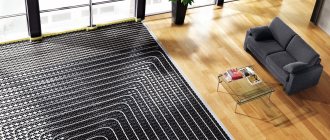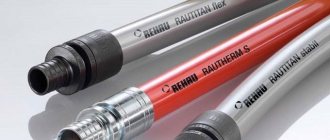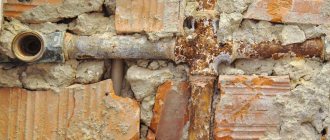Is it possible to paint hot radiators?
When painting heating radiators and pipes, the surface temperature should be taken into account.
It is definitely not worth painting appliances in winter, and especially during the heating season. Applying paints and varnishes to a hot surface can lead to accelerated drying of the coating and the appearance of minor defects in the form of sagging and stains. In addition, when processing a hot radiator, the sharp smell of paint may increase, and ventilating the room in winter is fraught with heat loss.
The most suitable time for carrying out repair work is a warm period, when the radiators remain cold, and it is also possible to ventilate the room well.
If it is impossible to postpone painting the radiator until the beginning of the heating season, then you need to wisely choose working equipment and materials. For work, it is better to use a spray can, which allows you to quickly and evenly apply the heat-resistant composition to the surface to be treated. The lower part of the structure and pipes should be treated with a brush.
When choosing paint and varnish products, it is important to consider its quality and performance characteristics. For example, it is better to paint a hot radiator with alkyd enamel
A more affordable and safer option to paint a switched-on radiator is to use a quick-drying acrylic compound. This coating is resistant to temperature changes and high humidity.
Iron pipe painting technology
Paint for hot metal pipes does not differ in its characteristics from the compositions used for polymer surfaces. But the technology of work may differ slightly. After all, on old metal pipes and radiators there is always old paint that needs to be removed. It is better to choose technological methods for removing old paint. For example, use a grinder with brushes. In this case, the work will be completed much faster than sanding the radiator by hand.
Before painting, the surface is treated with a primer or anti-corrosion compound. Pipes can be painted using the same tool as for polymer ones. Paint for hot heating pipes can be used of any of the types described earlier. In this case, you can paint warm heating pipes.
When giving advice on painting radiators, one cannot help but pay attention to safety precautions:
- use gloves when working;
- protect your eyes from paint;
- When working with an angle grinder, wear safety glasses.
Now you know whether it is possible to paint heating pipes during the heating season.
Which batteries can and should be painted?
From the point of view of common sense and to ensure safety, it is mandatory to paint heating devices that are susceptible to corrosion, that is, made of steel and cast iron. But there has long been a tradition that window slopes and window sill niches are painted white, and radiators are also preferred white. In any small store, the entire range of heating appliances is painted white, and only in construction hypermarkets can you occasionally see aluminum or colored radiators.
Cast iron
When people talk about painting batteries with their own hands, the first thing that comes to mind is cast iron radiators - reliable, heavy, “eternal.” If you have such radiators in your heating system and are satisfied with the safety of heating your house or apartment, then perhaps you should not change them. If you live in an apartment building, then replacing the heating system may lead to disagreements with the heat supply organization. In a private home, cast iron has its drawbacks, but changing it without reason also makes no sense. But periodic cleaning and painting with your own hands is necessary for cast iron.
Aluminum and bimetallic
You can also paint aluminum and bimetallic heating devices yourself, but this painting is mainly done for aesthetic reasons. To paint aluminum yourself, you need special primers. In bimetal, the steel core is usually not visible, and the aluminum shell is painted.
Copper
Copper batteries oxidize, darken and become less attractive. Therefore, copper radiators and pipes are also painted with your own hands. For copper heating systems, a special primer for non-ferrous metals is used.
Materials and tools
Often people paint only the front part of the radiator, but this is wrong. Rust may form on the reverse side and spread over a large area. High-quality paint will help prevent the spread of corrosion. You need to buy a special paint in the store that is resistant to high temperatures and retains its color for a long time.
You can choose any shade of paint, not necessarily white, the main thing is that the tone of the battery fits into the design of the room. In the nursery, you can paint the heating devices with bright paint, you can even paint a landscape on the panel devices.
Before you start painting radiators, you need to prepare the following tools:
- scraper for removing old paint surface;
- sandpaper;
- several brushes;
- roller;
- a rag.
Is it possible to paint a battery in an apartment with acrylic paint?
The process of painting a heating radiator is often accompanied by the question of whether it is possible to paint the radiator with acrylic paint. Is it possible to paint hot batteries? What paint and varnish product is better to choose for a heating radiator?
Painting the heat exchanger is often an essential part of a renovation, although it can simply be a design move to bring a pop of color into the home. They are also tinted as the current top painted layer wears out, or they are simply painted with patterns on top of the existing one. Regardless of the type and volume of work, it is better to approach the choice of means responsibly.
Selection criteria
There are quite a lot of requirements for all types of coatings for heating radiators. The paint must be resistant to high temperatures, at a level of 90-100°C, protect the metal from corrosion, adhere well to the surface, not change color over time and be non-toxic. Modern hardware stores offer a wide selection of paints and emulsions of all possible colors and shades. Most people are accustomed to the fact that a heating radiator should be white, but some strive to turn such an ordinary item into an original interior detail. After all, this beautifully painted object can become a highlight, a harmonious detail of any, even the most elaborate interior.
Some experts believe that color affects performance. Dark colors increase the heat transfer of the device, while light colors slightly reduce it. Now the choice of coatings is very large: there are separate products specifically for radiators; you can also use various enamels, heat-resistant varnishes, and water-based paints.
However, each type of coating has its pros and cons. So you need to carefully analyze everything before purchasing.
Acrylic enamel
The main advantage of acrylic enamel is its very high heat resistance to yellowing, it is 100°C, for some - up to 120°C; in home conditions it will not turn yellow, since heating radiators simply do not heat up to such temperatures. Their main operating mode is 40-60°C. Also, this enamel is considered to be quite durable, which allows you to preserve the decorative appearance of the painted device for a long time. An advantage to the positive characteristics of acrylic coating is that the applied layer dries quite quickly, 2-3 hours. More accurate information is usually indicated on the paint can.
Some people are interested in the question of whether it is possible to paint hot batteries. Answer: the acrylic product allows you to paint even warm radiators.
A special feature of these enamels is that they are produced using organic solvents. So during the dyeing process a weak characteristic odor of solvent is released, which, however, evaporates quite quickly. However, thanks to this component, the paint acquires a beautiful glossy shine when dry. But after drying, the color may change its shade slightly. Typically acrylic darkens as it dries. This enamel has excellent mechanical resistance, UV resistance and does not allow steam to pass through. In addition, they are endowed with water-repellent properties and are resistant to cold after complete hardening.
They are diluted with water, but when dried, as their names suggest, they do not acquire their characteristic shine. These products are often more expensive than glossy enamel, but they are better at hiding dents and other small surface defects that appear when coated with glossy paint. It takes about 10 hours for a battery painted with acrylic emulsion to completely dry.
So if you decide to paint the batteries with acrylic paint, choose which option suits best and paint.
This is interesting: DIY drywall lift - drawings and diagrams
Paint selection
People often think that only the front side of the battery needs to be painted, but this is absolutely not true. Rust appears on the surface of the metal, which spreads over time if it is not eliminated. The problem of corrosion can be solved with high-quality paint. To make the right choice, you need to know the main characteristics of this product.
The paint must be resistant to high temperatures, because in winter the battery gets very hot. A high-quality coating will allow the color to last for several years.
To select the right paint, you need to understand the types of paint available for sale:
- Acrylic paint has no odor at all and can even be used in a children's room. In addition, its color remains natural for a long time. This option is most suitable for winter repairs, since there is no need to ventilate the room after painting.
- Alkyd paint is quite resistant to elevated temperatures and is an excellent material for covering a radiator. Its main disadvantage is its strong odor, which means its use during the heating season is not recommended.
- Battery paint is a type of acrylic paint that must be mixed with a solvent. This material has its advantages: it can be used without prior priming the surface, the coating is glossy and uniform.
- Oil paint has fallen out of use over time, although it is known to everyone.
In this video you will learn how to properly paint radiators:
This listing is for cast iron batteries. For panel radiators, it is preferable to use auto enamel in an aerosol.
White radiators are no longer in fashion. You can experiment with color, but keep in mind that the battery must fit into the overall concept of the apartment. The radiator in a child's room can be decorated with patterns or even a landscape.
We recommend: Water heating from a wood-burning stove: do-it-yourself stove with a water circuit, register for stove heating, brick stove with water heating, masonry
Everyone chooses a more suitable option for coating material, but in order for the paint to apply evenly, the following tools are needed:
- sandpaper;
- sharp spatula for removing the old layer of paint;
- 2-3 types of brushes;
- small roller;
- rags for cleaning.
This kit is needed for high-quality painting, which will transform old and rusty batteries into a beautiful piece of furniture.
Antique painting
You can turn your old batteries into a real work of art by painting them in a vintage, retro style. This applies to various cast iron radiators, whose ancestors appeared in houses at the beginning of the last century. Here enamels with powders in silver, gold or bronze will come to the rescue. Of course, the easiest way is to buy silver paint in an aerosol can and quickly apply it to the battery, as done in the video:
After drying it, the picture can be supplemented with shadows from flowers or butterflies using paper stencils. This work is not easy and requires patience and time, but such a battery will look beautiful in any interior. How to properly produce antique painting and patination is shown in the video:
Is it possible to paint heating pipes and radiators in an apartment when they are hot?
What to do if the heating radiator and pipes have lost their aesthetic appearance: the paint has peeled off and rust has appeared in places? It is definitely necessary to paint them, but what paint should I use, what tool should I use? And in general, is it possible to paint hot heating pipes in an apartment during the heating season or is it better to wait until the summer when the radiators are cold? You will find answers to these and many other related questions in this article.
- Is it possible to paint hot heating pipes in an apartment?
- Choosing paint for pipes
- Is it possible to paint hot heating pipes in an apartment using a non-professional tool?
- Technology for painting polymer pipes
- Iron pipe painting technology
Is it possible to paint hot heating pipes in an apartment?
If you use a special dye correctly, you can give pipes and radiators a pleasant, updated look even during the heating season. But when choosing such paint, you need to have certain knowledge. After all, the work will be carried out in a residential area, therefore, special requirements are imposed on the dye:
But even when choosing a paint with optimal characteristics for painting batteries, the average person can make a lot of mistakes when painting, since they still need to properly prepare the surface, select a tool and perform the work properly. More on this later.
Choosing paint for pipes
The answer to the question: is it possible to paint hot pipes has already been provided, so let’s move on to choosing a dye. Today there are several types of paint that are a priori suitable for treating hot radiators.
- alkyd enamel - the surface treated with this material can be matte or glossy. The paint creates a durable coating. Among all the variety of these dyes, there is a special one for radiators, which can be applied to hot pipes. In addition, the enamel will create a barrier against rust formation;
- acrylic paint - has proven itself well at home, as it is easy to use and does not emit an odor when drying due to the fact that it is water-based;
- oil paint - this material is hopelessly outdated due to its characteristics (it takes a long time to dry, has a pungent odor), so we will not consider it;
- spray paint – suitable for use in industrial environments, requires special application skills. This material is not suitable for use in the home;
- silicone-based dye - due to the cost and specific application, such paint is significantly inferior to the first two options;
- a dye based on heat-resistant varnish - excellent for heated pipes, but in a city apartment or private house the radiator temperature is unlikely to rise above 90 degrees, so using such a dye is not advisable;
- water-dispersion paint - dries quickly on a heated surface, which interferes with high-quality film formation. Moreover, such a dye already has poor abrasion resistance - it is not suitable.
Of all these paints, the ones that have proven themselves best are: alkyd enamel and acrylic paint. But they have two drawbacks: alkyd enamel emits an odor, and acrylic enamel does not protect against rust. To avoid the unpleasant odor from alkyd paint, you can use acrylic paint, but before that you need to apply a layer of primer to the batteries. This paint for hot heating pipes holds up quite well and does not darken over time.
Examples of enamels for painting radiators
Among the range of special radiator paints, there are options that are better suited than others. For example, among alkyd enamels, the Swedish paint “Elementfard Alkyd” is superior in its characteristics to competitors (it emits very little odor, dries quickly, is used at surface temperatures up to 100 degrees, does not require priming). And also the Dutch paint “Radiator Paint” helps to positively answer the question: is it possible to paint pipes during the heating season? After all, its range of application up to 90 degrees is enough to paint hot pipes.
Painting hot batteries
After preparing the radiator, you can proceed directly to painting. A few recommendations when painting the battery:
Painting should be done with a brush, not a sprayer. The brush must be thin enough to fit freely into the space between the battery sections;
- Painting of the battery begins from its upper part, preferably from the inside. If you do not want to stain the floor with paint, then you should place newspapers or plastic wrap under the radiator. The wall behind the battery should be covered with tape or at least covered with cardboard. And in order to better paint the back of the radiator, you should take a special brush with a rounded handle;
- It is recommended to apply paint in several layers, but they should not be too thick, otherwise the battery will take a very long time to dry. It is best to apply one coat, wait until it dries, and then apply the next one;
After the battery is painted, you need to leave the room and wait until the paint is completely dry. If there is such an opportunity, then it is worth opening a window or at least a window.
Painting a battery in winter is not such a difficult task. The main thing is to choose a good heat-resistant paint and apply it correctly.
Very often we receive the question “How much does it cost to paint a square meter of our part?” It would seem that everything is simple, but to answer such a question, you need to know a lot of input data.
Let's figure out what really affects the cost of painting a product:
The surface area of the product to be painted; The color in which the product must be painted (the cost of paint according to the RAL classic catalog can vary from 4 to 20 or more Euros per kg
paints); The thickness of the metal from which the product is made (for a metal thickness of 2 mm or more, we introduce a coefficient for additional heating); Number of products to be painted; Product dimensions (it is important to understand how much space the product takes up in the polymerization oven)
Let's give examples for clarity:
We paint a galvanized iron sheet 2 mm thick and 1000*1000 mm in size on one side. In color according to RAL 5017, smooth gloss. Quantity: 20 pieces. Those. The painting area is 20 square meters. meters. The cost of painting is 2960 rubles including VAT.
Now we paint the frame, welded from a 20*20*1.5 profile pipe, measuring 1000*1000*1000 mm. The result is a rectangular parallelepiped with a surface area of 0.96 sq.m. According to “straightforward” logic, the cost of painting such a product should be 142 rubles including VAT. The price for powder coating of such a product does not even cover the costs, and you need to calculate the price for powder painting of a part using a completely different formula.
Only a manager who understands the subject and has all the data for calculation can calculate this.
Don't waste your time guessing the cost! It’s better to call or write to us right away - a specialist will quickly calculate the exact cost of painting, report the result in a call back or write to you by email.
Which paint to choose for hot surfaces
Choosing the right type of paint is not difficult. The label always indicates the purpose of the paint and the permissible temperature range. The most popular brands are Tecurilla, Fincolor, Marshall. There are also domestic versions of such paints, which will cost a little less than foreign ones, but their quality is significantly lower.
Which paint should you choose? It doesn't really matter much. The best samples are almost indistinguishable from each other and have proven themselves to be excellent. The only differences between one brand and another may be in the color palette and small, very insignificant differences in recipes.
Calculation of paint for pipes and batteries
Another important step is to correctly calculate the required volume of materials used for painting radiators, pipes and other elements of the heating system.
For the calculation, the initial data is used:
- Surface area to be processed.
- Consumption rate of a specific type of paint per 1 sq. m.
The paint consumption is calculated and indicated by the manufacturer on the packaging. Each element of the system has its own area, which is taken into account when calculating the volume of paint. Such information is contained in the technical characteristics of each heating device. If painting of pipes is required, it is necessary to additionally calculate the area of each of them, multiplying the length of the pipe by its diameter and the number P.
The obtained values (device area) and paint consumption per 1 sq. m are multiplied to obtain the exact volume of paint in units of calculation - liters. This volume is taken into account for applying one layer. If you need to paint in several layers, the paint consumption per layer is multiplied by the total number of layers.
Quantity of paint
The manufacturer usually indicates for which heating area a given amount of paint is intended. It is taken into account that the first layer will require more paint and varnish materials, and less for the second and third. For a typical single-section cast iron radiator brand MS-140 with an area of 0.2 - 0.25 sq. m consumption will depend on the type of paint. When going to the supermarket, you need to count how many ribs each battery has and how many layers you plan to paint. Managers will calculate the amount of paint so that there is enough for all the details. It’s better to round up so you don’t have to buy 100 ml of coating in case there isn’t enough.
Before painting batteries, it is necessary to carry out preparatory operations:
- Clean the surface from dirt.
- Inspect the radiator for corrosion.
- Remove rust using sandpaper.
- Remove old paint with a spatula.
- Apply primer to level the surface.
- Prime the base.
- Place cellophane under the battery.
Attention. To quickly remove old paint, the best solution is to use a drill with an attachment. It is important not to press too hard so as not to damage the metal.
Careful surface preparation
In this case, the remaining paint is completely removed. This is done like this:
- the radiator is heated using a gas burner;
- then large pieces of paint are broken off with a spatula;
- the surface is thoroughly cleaned with sandpaper, or better yet, with a drill with an iron brush attachment.
After these procedures, the radiator is wiped with a damp cloth in order to degrease and remove dust. If you paint it properly after this procedure, it will definitely look like new.
By the way, in order for it to work as if it had just been brought from the factory, an additional procedure must be performed. Namely: you need to remove it, drain the water, heat it up very much, let it cool, then disassemble it and clean it of accumulated debris and rust inside. Then, carefully assemble it back, using rubber cut from ordinary tires as spacers.
How and with what paint to paint an old, hot, cast-iron battery?
Surely, everyone who has encountered repair problems knows that one of the most unpleasant undertakings is painting old radiators (more correctly, heating radiators). Particularly “pleasant” is the coloring of finned cast iron radiators. Of course, many will take the path of replacing them with new ones (fortunately, now there is a choice), but what should those who do not have such an opportunity do, and the question of updating is already looming.
Which paint to choose?
Many companies offer so-called radiator paints. But they are unreasonably expensive.
Materials that resist heat
Radiators are a weak link, since contact with water promotes the formation of corrosion spots
It is to prevent it that regular coloring is so important. The compositions also need to be used special: they should not peel off, be afraid of elevated temperatures, and also be able to maintain shine, protective film and color for a long time
Another requirement is the absence of a pungent odor, which is simply intolerable during the heating season, and is also extremely dangerous.
To paint hot batteries, it is recommended to purchase the following types of materials:
- Acrylic. Such compositions are completely devoid of a sharp suffocating odor, so they can even be used in children's rooms. They can withstand temperatures up to 80°, just the temperature of a battery that usually does not exceed, or does so extremely rarely. Other undoubted advantages are fast drying (one layer per hour), long-term preservation of the original color, and reasonable price. This is the best option and does not require long-term ventilation.
- Alkyd. These paints (enamels) are champions when it comes to heat resistance; they can easily withstand temperatures up to 150°. But such compositions are very “fragrant”, so high-quality, long-term ventilation is needed, and frosty winters are unlikely to force the owners to dare such a feat. Another Achilles heel of enamels and paints is the gradual appearance of a yellowish tint on light-colored coatings.
- Special compositions - for radiators. They are a type of acrylic paint, they are mixed with special solvents. Their advantages are excellent covering ability, a glossy film that remains on the radiator for a long time. Before painting batteries, there is often no need to prime the surface.
- Oil paints are the most famous, once practically the only type. Now it has been replaced by new materials, since these compounds take too long to dry, have a strong odor, and the coating cannot boast of durability.
- Water-based formulations are another suitable candidate because they are odorless. But it also has disadvantages: the material dries out quickly, which makes it impossible to form a high-quality film, and has insufficient abrasion resistance.
In addition to the above materials, aerosol automotive enamels can be used to paint batteries. This coating option promises uniform coverage even in hard-to-reach places and speeds up work. Economical material consumption is another advantage of this option.
What is the best way to paint warm batteries?
The action of warm water causes premature failure of heating radiators - over time, pockets of corrosion are revealed on the metal surface. In order to prevent this process, special types of paint should be used to paint batteries.
A high-quality paint composition should be able to withstand elevated temperatures, have a stable film structure and maintain its original tone for a long time. In addition, if the owner prefers to do repairs in winter, you need to choose paint without a strong odor .
To paint heating radiators during the heating season, it is recommended to use the following types of paint:
- Alkyd. This material does not have a strong odor, retains its original shade for a long time and is excellent for interior metal work;
- Acrylic. Paints based on this base have excellent resistance to elevated temperatures and are ideal for application to household heating radiators. Acrylic compositions retain their color for a long time, but have an unpleasant odor; therefore, the use of these paints for interior work is limited. There is a variety of acrylic paints that need to be mixed with special solvents; they are distinguished by higher hiding qualities and an impeccable glossy film, and to apply this paint you do not need to pre-prime the surface;
- Oily. Durable and high-quality paints, but they have a significant disadvantage - they take too long to dry.
- Read also: Which specific heating radiators are better - aluminum or bimetallic? In addition to the paints listed, it is possible to use aerosol cans with car enamel to paint radiators. The sprayer greatly facilitates the work and allows you to use material economically.
Painting process technology
Now let's look at how to paint a radiator to achieve a good result. This must be done with the heating turned off, otherwise in some areas the paint will dry too quickly, lay down in an uneven layer, and smudges will form that look unsightly. Of course, there is a special paint on sale that is intended for use on hot radiators, but it can also go unevenly if the heating is not turned off.
Currently, heating radiators are painted in colors that best suit the overall interior design of the room.
If there is no other way out and you have to paint the heating device during the heating period, then you need to at least turn off the hot water supply yourself or make this request to the housing office employees. In this case, the temperature at the radiator will drop significantly.
So, if you have already decided which paint is best to paint radiators, you can proceed directly to the painting process:
- First of all, you need to take care to protect the floor from contamination with paint stains. To do this, lay unnecessary paper or fabric under the batteries.
- Choose small brushes with soft bristles, one straight and the other curved, to paint hard-to-reach areas.
- Apply paint first to the top of the battery and move towards the bottom. Paint the battery on all sides: first the internal ceilings, then the external ones, to avoid staining hands and clothes. After the 1st layer of paint has dried, apply the second. You need to remember the rule that two thin layers of paint are better than one thick one. After all, only in the first case will a uniform and smooth paint coating be guaranteed.
The radiator can also be painted with a spray gun or from a spray can.
Painting a heating radiator with heat-resistant paint from a spray can is convenient and quick, while the paint lays down in a thin, uniform layer
When using a spray gun, it is recommended to remove the battery so that you can paint all hard-to-reach areas. Painting using a can filled with heat-resistant paint is done very quickly and efficiently. Typically, detailed instructions for painting surfaces with a spray can are given on its packaging. The basic rule: perform zigzag movements from top to bottom at approximately a distance of 30 cm from the surface to be painted.
Before painting heating radiators, it is important to study the technology of this process, because compliance with it will ensure the attractive appearance of the heating device and its reliability
How to paint
How to paint radiators? The instructions depend on how much time you are willing to spend on painting and generally bringing the radiators to normal condition.
Easy way
- The surface of the battery is prepared in two stages: first, the paint layers are heated with a hair dryer or gas torch and removed with a hard spatula; then the surface is cleaned with a wire brush.
Useful: in articles on the topic of painting, it is often recommended to clean the radiator before painting with sandpaper. The author has serious doubts that the people giving such advice have ever tried to do this work. Sanding at least 7 sections clean is VERY tedious.
The photo shows an attachment for a drill, which can simplify the work even more.
- Dust and rust residues are removed with a damp cloth.
- Then the paint, diluted to the state of rich milk, is applied in two thin layers, allowing each of them to dry completely (usually for at least a day).
There are few subtleties here, and, from the author’s point of view, their importance is exaggerated.
- Do not try to paint the radiator in one go if the paint layer is visible. It is better to spend a day drying and apply another layer, otherwise you will encounter sagging and uneven coloring. However, if this does happen, it’s not a disaster; it’s enough to selectively clean the surface area again and apply another THIN layer on top.
- Is it possible to paint hot radiators? Advice based on personal experience: yes. But put VERY little paint on the brush at a time, QUICKLY rub it in as thin a layer as possible and ventilate the room well.
In this case, you will not be poisoned by quickly evaporating paint thinner, and you will not paint the radiator with untidy streaks (paint dries very quickly on a hot surface).
The right way
How to paint a heating radiator, completely returning it to the appearance of a new one, removing all the stains between the sections and the flaws of previous paintings?
The painting itself is done in the same way as in the previous case - with a brush, in two thin layers.
But the preparation of the radiator will be different:
- After dropping the risers, remove the radiator and drain the remaining water from it.
- Unscrew all the plugs - blind and straight. Remove the flushers.
- Burn the radiator for at least an hour over a regular fire in the yard. Annealing with a hairdryer or blowtorch will be tedious and ineffective.
- Disassemble the cooled radiator into separate sections using a radiator wrench: after annealing, this is easy to do.
Sections 1 are connected by nipples with oppositely directed threads: right 2 and left 3. To understand which way to turn the radiator key 4, just study the threads on the edge of the section after unscrewing the plug.
- Tap each section with a mallet. At the same time, the rust that has accumulated over many years will spill out of it, cleaning the channels inside.
- Clean sections with a wire brush. After annealing, the procedure will be quick and easy.
- Reassemble the radiator using regular rubber gaskets. They are easy to cut from an old car inner tube. The outer size is slightly smaller than the end of each section. In this case, the compressed gasket will not protrude beyond the edges.
- Mount, press by simply filling the riser and paint. You have a radiator that is free of contaminants and in factory-new condition, with the highest possible heat output and impeccable appearance.
The battery is not just painted: it will heat up no worse than a new one.
Radiator paint
Now let's move on to paint types. Special paints for heating systems are alkyd and acrylic; there are also varieties of them - they are made on different bases.
Alkyd enamels
This group has a very wide range of shades, there is a smell, but not very strong, it disappears after a few hours. You can use them with confidence: they will not turn yellow or fade. But alkyd enamels for radiators come on different bases:
The manufacturer and its purpose must be indicated on the paint can.
Acrylic enamels
Acrylic enamels after drying resemble a plastic coating. The effect is complete: both in appearance and to the touch. This paint holds up very well and washes well. But there are several types, with different properties. They are water-based and virtually odorless. Also called “acrylate enamels”. But you need to look for heating systems designed for painting.
A good option is VD-AK-1179. But this paint must be applied to primed or previously painted metal. Drying time before applying the next layer is 2 hours, complete drying is 24 hours (the cost per liter jar is about 600 rubles).
There are a lot of manufacturers of paints for radiators and heating pipes
With a smell, but includes anti-corrosion additives “Thermakrill” from the ALP ENAMEL campaign. The declared temperature is up to +120 o C, has anti-corrosion properties, is suitable for painting any steel, including stainless, low-carbon and galvanized, aluminum and titanium alloys. Can be tinted in any shade. Drying time before applying the next layer at 20 o C is 20-30 minutes, complete drying is 2 days.
There are many other enamels of this class with different characteristics. Choose the option that suits you best.
Hammer enamels
This is a very interesting version of alkyd enamels, allowing you to achieve non-uniform coloring using only one paint. Depending on the type of pigment, the surface may have the appearance of embossing, hammering, and other effects. The heterogeneity of color hides defects and unevenness of the base very well. The preparation of the base is standard: removing rust, old paint, stripping to metal, degreasing to a “clean rag.” When applied to smooth and glossy surfaces, it is necessary to create a rough base (treat with sandpaper).
Hammer enamels give a very interesting effect that will hide many surface imperfections
Powder paints
This is a modern painting method used to paint aluminum. bimetallic and steel radiators. It is difficult to implement at home. It's a matter of technology. Powder paint is dry and sprayed from a special gun. It costs about $40-60, but you can find an organization that rents equipment.
The part to be painted (prepared and cleaned) is given a negative potential, while the powder is given a positive potential. To “charge” the part, a diesel engine is needed, which can produce fractions of an ampere at a voltage of 25-30 kV.
Due to the potential difference during spraying, the powder is evenly distributed over the surface of the part. The applied coating then requires polymerization: creating conditions under which the applied powder turns into a single, rigid coating.
Powder coating gives a durable and smooth finish, but it is a complex process
Most often, this condition is heating to certain temperatures. The heating temperature can vary from 170-200 o C to 350 o C. At a low polymerization temperature, heating the part with an ash gun may be enough, but at a high temperature, the part is placed in a special oven (used costs about $60), where it is gradually heated . There are also compositions that polymerize under ultraviolet radiation. Everything is simpler here: in a closed space they turn on an ultraviolet lamp and keep the part for a certain period of time.
In any case, it is quite difficult to create such conditions at home. If there is a need for powder coating, you can contact a specialized auto repair shop; maybe they have similar equipment and will agree to paint the radiators for you.
As you can see, the choice of colors is quite wide. The only type that is not recommended is oil paints. They, in fact, have already outlived their usefulness. But if you prefer them, you can use them.
How to paint heating radiators
We already know what type of paint we should use to paint our heating radiators - all that remains is to figure out exactly how the painting is done. To do this, you need to prepare brushes, primer (if necessary) and sandpaper. How to remove paint from radiators? You will have to work a little with sandpaper or a special brush for an electric drill. We recommend choosing the latter option as it is faster.
Before painting the radiator, be sure to strip it of the old coating and use a primer for better adhesion of the primer to the surface.
Before applying paint to the batteries, they must be completely cleaned with sandpaper or a brush , and then treated with a degreasing compound - this will ensure more reliable adhesion of the primer to the surface. If necessary, treat the batteries with a primer and let them dry. After this, we begin to apply the paint - it is applied from top to bottom to avoid drips. If you want to get a smooth surface, use a paint sprayer (be careful, careless handling of this tool will lead to smudges).
When is the best time to paint radiators? Some paints can be applied directly to hot surfaces. But you must understand that in this case you will encounter intense evaporation of the solvent - it will be impossible to breathe in the room. In addition, due to drying too quickly, the paint begins to warp, and smudges will harden almost instantly. If you are faced with the task of obtaining the strongest possible layer of paintwork, paint radiators in the summer - this is the only way you will achieve positive results.
Do-it-yourself painting of heating devices
The workflow for painting batteries and pipes with heat-resistant compounds includes several stages:
- Preparation of the treated surface.
- Application of coloring composition.
To carry out the work you will need the following tools and materials:
- Brush with a metal base.
- Paint brushes – regular and radiator.
- Coarse sandpaper.
- Cleaning brush.
- Spatula with a metal tip.
- Primer for metal.
- Paint for batteries.
- Degreasing or solvent composition.
Preparing surfaces for painting
To perform high-quality painting of heating devices with your own hands, you need to properly prepare the surfaces. Preparatory work includes the following activities: cleaning of old coating, removal of corrosion, degreasing and priming.
- The surface is thoroughly cleaned: the old coating is removed, areas damaged by corrosion are sanded to a shine. Dirt is removed with a brush, and paint with a spatula or special chemicals.
- After removing the paint, the surface is sanded with a brush with metal bristles, a special attachment for a drill or a grinder. When working with surface cleaning, personal protective equipment is used.
- The cleaned surface is sanded with sandpaper and degreased with any available solution.
- A primer with anti-corrosion properties is applied to the prepared surface for maximum protection against corrosion and increased adhesion of the paint composition to the base.
Features of surface painting
Most modern compounds are applied to a cold surface, so the hot battery must be cooled before painting. To obtain a high-quality coating, it is recommended to paint batteries following a certain technology.
Liquid formulations
If the work uses an oil, water, water-based or other liquid composition, it is necessary to properly prepare the workplace and protect the surrounding surfaces with a clean rag.
- For painting, use a brush with a curved handle or a soft sponge. The coloring agent is poured into a wide container. Hands are protected with gloves.
- The composition is applied in a thin layer to the internal surfaces and in hard-to-reach places, then the outer part of the heating device is treated. Smooth strokes are made from top to bottom, which will allow you to evenly apply the enamel to the surface.
Aerosol formulations
If odorless spray paint is used for painting, the principle of surface treatment is as follows:
- First, hard-to-reach places are processed, then the outer parts of the central and other heating elements.
- Smooth movements are performed in a zigzag manner from top to bottom.
- The surface is treated in two layers to obtain a uniform coating.
If enamel for radiators is applied using a spray gun, then the principle of surface treatment is similar to balloon painting.
Before painting heating radiators at home, you should carefully study the features of the technological process, because compliance with all stages will ensure high performance characteristics and a long service life of the devices.
How to clean a surface from old coating
Preparing the surface of radiators and pipes begins with removing the old paintwork. There are two simple ways to clean radiators:
- The mechanical method involves using a brush with metal bristles or an attachment to an electric drill. Dismantling the coating is carried out down to the metal, so it requires a lot of time and physical effort. The only drawback is the difficulty of processing small parts or hard-to-reach places. A special attachment for the drill simplifies the cleaning process, and it also allows you to better process the entire area of the device, even in hard-to-reach places.
- The chemical method requires the use of special chemical compounds based on acids and solvents that reduce the adhesion of the coating to the base. The surface is carefully treated with the selected composition according to the instructions until the paint is completely softened. Next, the old coating is removed with a spatula, grinder or brush.
We recommend: Installing a circulation pump with your own hands: instructions, connection, photo of work
Painting stages:
As mentioned above, you can paint both cold and hot surfaces with PF-115 paint. Only hot ones dry faster, which sometimes happens for the better.
— First, it is advisable to paint hard-to-reach places (ribs and the back side) and then bring complete beauty to the front surface. This will save you from unnecessary inconvenience and from getting dirty with paint.
— It is useful to have a small mirror when performing such work. When it seems to us that everything has already been painted, it would not be a bad idea to look at the back of the pipe or radiator with its help.
You will be able to see many flaws in your work and eliminate them.
— Places where the old paint has peeled off and fallen off, sometimes you have to paint it several times and more thoroughly. But as a result, the entire surface is painted fairly evenly and the batteries look renewed.
All the proposed tips do not require additional financial costs for rationalization, significantly simplify the process and reduce the effort and time spent on painting. And the result of the work done will definitely please you.
Article rating /
Give your rating!
5 5 5
Use of alkyd paints
The use of paints with an alkyd composition when applied to hot surfaces can be characterized exclusively on the positive side. After all, they can withstand temperatures up to 150 degrees. And they don’t change color unless the temperature rises above 120. The only negative is the unpleasant smell. It will not only be present during the dyeing process, but also for some time after. Also, if the heating was turned off and turned on , you can again feel the familiar chemical aroma. But after a short period of time it will be inaudible.
Radiator painting
If you need to make repairs in the cold season, then now you know that you can paint hot radiators, how best to do it and with what. Be sure to wear a respirator if you choose paint with a smell and ventilate the premises. Good luck with your renovation!
What batteries can be painted?
Painting stationary heating elements is a responsible process; not only the appearance, but also the heating of the room depends on the correct execution of all actions. That is why you should take into account the recommendations of specialists who will allow you to carry out the work efficiently.
Radiators are divided into types depending on the material used for their manufacture.
Aluminum and bimetallic heating elements. This is a modern variety that is carefully powder coated in-house. With its help, it is possible to obtain a reliable and durable coating that is practically not damaged over time. Most often, the question of repainting arises from the desire to change the appearance of the product. But removing the layer at home without damaging the structure is a difficult task. If you lay a new coloring composition on an old surface, then it is very difficult to achieve a high-quality result. In addition, this will lead to a noticeable decrease in heat transfer, so it is recommended to cover such devices with special screens.
Plate radiator. This option is much less common; it is used for buildings in which the network is under serious pressure. The design of this product consists of many closely spaced plates and has a large area. This is what makes painting very difficult. Practice shows that an acceptable result can only be achieved by removing the element from its place and thoroughly cleaning it. The composition is applied using a spray gun or spray can. In this case, only the external parts are painted.
Cast iron battery. It is cast iron that is most suitable for implementing interesting design solutions. This heating element can be easily painted with various compositions.
It is very important that the applied coating does not reduce the level of heat transfer. Panel products. To obtain the desired result, spraying options are used as a painting tool.
To obtain the desired result, spraying options are used as a painting tool.
Preparatory work
It is necessary to prepare the surface for painting in advance. The quality of the coating depends on this.
When preparing a radiator for painting, perform the following work:
- First you need to clean the heater from dirt.
- The battery is then inspected to look for rust.
- Then, using a scraper and sandpaper, remove the old paint.
- After the surface of the battery is cleared of the old coating, the battery is treated with a primer solution.
- Then a primer is applied, this will level the coating, remove unevenness, and ensure adhesion of the paint to the surface.
- The primer is chosen depending on the type of paint.
- The work area is covered with cellophane, and both the floor and the wall should be covered.
The main difficulty of the preparatory stage is removing the old paint. There are several methods for removing old coating. The most accessible is the chemical method.
To prepare a chemical composition for paint removal you need to prepare:
- 1 kg of calcined salt;
- 1 kg lime;
- 5 liters of water.
Painting recommendations
- The quality of painting of cast iron batteries also largely depends on how well they are prepared. A smooth foam roller of small diameter is optimal as a tool for applying paint, and a brush is useful in hard-to-reach places. To decide for yourself how to paint most conveniently, you should think about removing the batteries. The radiator, separated from the pipes, can be coated with the composition on all sides, so there will be significantly fewer hard-to-reach places. However, this method does not always pay off; sometimes it is easier to paint the battery more thoroughly without wasting time on removing it. It all depends on the specific circumstances and the shape of the radiator.
- A very important factor is the temperature of the surface to be painted: the radiator must be cold. To the question “is it possible to paint hot batteries?” any specialist will answer unequivocally: this cannot be done. The most convenient moment is when there is no heating season. But the beginning of the heating period will not be a hindrance if you close the valves on the radiators, stopping the access to boiling water. It is enough to wait until they cool completely to start painting. If paint is applied to a hot radiator, it will lie unevenly, swell, and various stains and stains will probably form. Moreover, you can turn on the heating only when the paint is completely dry.
ATTENTION: Never paint hot batteries!
Painting radiators and heating pipes requires care and precision. It is good to use brushes, small rollers, and spray cans. It is optimal to use a spray gun to process the previously removed battery, then all hard-to-reach areas will be perfectly painted. It is from those places that are least accessible that you should start painting
It is important to maintain a uniform layer thickness, otherwise the color may further differ in different areas. It is recommended to start painting from the top, then accidental drips will not spoil the lower part
You need to cover the entire battery with the composition, not limited to its front part.
It is more effective to apply paint in two thin layers, and wait until the first one has completely dried before painting again. Then there will be no drips, and it’s easier to achieve perfect evenness with thin layers.
Useful tips
Even without special skills, anyone can beautifully paint a heating radiator if they take into account the recommendations and some rules. There are some simple tips from experts:
- there should be no drips on the painted surface - to do this, you need to apply the paint in as thin a layer as possible, making smooth movements;
- It is more convenient to paint the back surface of the battery with a curved brush or toothbrush;
- When cleaning the device using a chemical method, you must adhere to the rules of personal protection;
- upon completion of painting work using any paint, the room should be ventilated, but it is better to use odorless paints;
- hidden heating elements and pipes do not need to be painted, this will ensure better heat transfer;
- Before purchasing paints and varnishes, you need to carefully study their characteristics.
There is no need to worry about whether heating radiators can be painted while they are hot. Modern materials can withstand fairly high temperatures without losing their properties. If you follow all the rules for preparing and painting the radiator, you can achieve the feeling of purchasing a new battery.
How you can paint hot radiators and what kind of paint to do it with - everyone decides for themselves. To the question of whether it is possible to paint batteries with acrylic paint, you can confidently answer in the affirmative.
